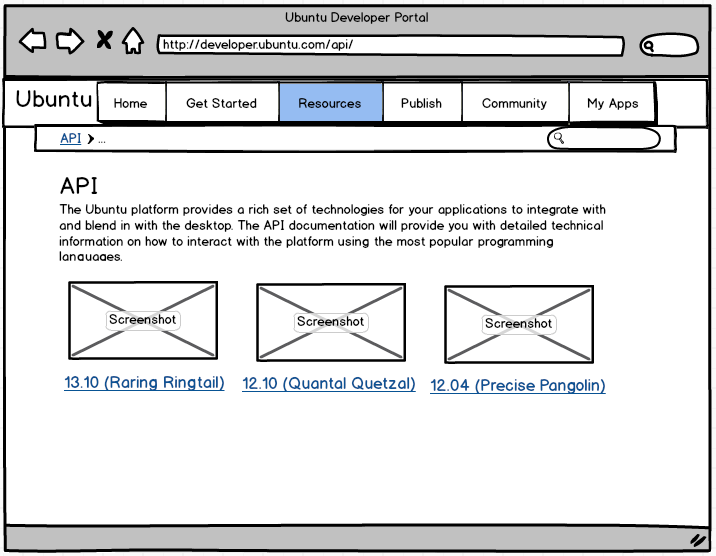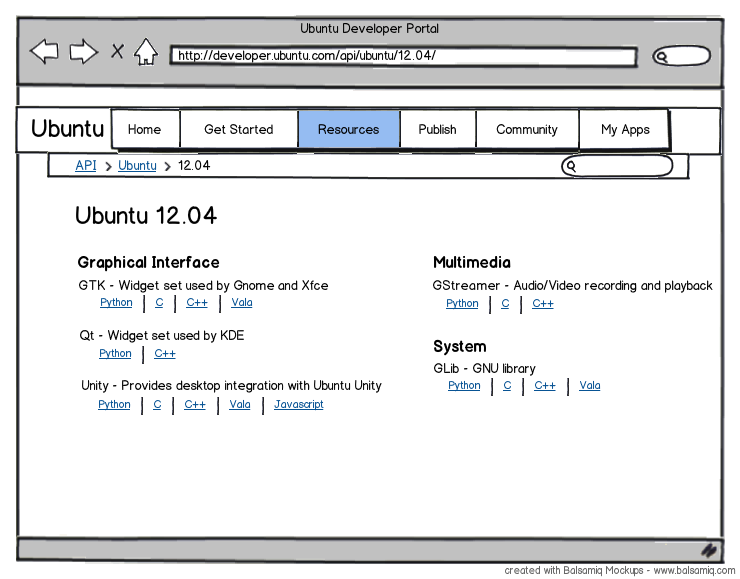DeveloperNetwork
Launchpad entry: https://launchpad.net/ubuntu-api-website
Created: 2012-06-28
Contributors: mhall119, jonobacon, john.vrbanac
Create a new web project for hosting searchable, browseable and editable documentation for the APIs that are used in Ubuntu application development.
Rationale
Our API documentation is sparse and in static HTML. This makes it difficult to find specific documentation.
Required Functionality
- Parse qdoc and save it in discrete fields in a database
- Display API in multiple programming languages (C++, QML/Javascript)
- Allow searching the API fields
- Allow multiple versions of the same API (Qt 5.0, Qt 5.1, etc)
- Define collections of API versions as a distro release (Ubuntu 12.04, Ubuntu 12.10, etc)
- Allow linking between one API and another
- Allow manual addition of descriptions, explanations and examples (using markup)
Data Model
The API data will be parsed from many different sources, pre-rendered into HTML, and stored along with meta-data about it in the database.
Users will be able to contribute snippets, linked articles and images to expand upon the generated documentation.
Common Models
These models will be used to define the platform that application developers can target. A platform is the combination of libraries and APIs provided by a given release of a distribution.
Distribution
This model will represent a reusable reference to a distro (Ubuntu, Kubuntu, Xubuntu, etc)
id - Auto-generated primary key
name - Name of the distribution
url - URL to the distro's homepage
description - Long text description of the distro
Release
This model will represent a specific release of a distribution, and will be used to define what libraries and versions of them are available in that release.
id - Auto-generated primary key
distro - Foreign Key to a Distribution record
version - Official release version name or number
name - Development codename for the release
released - Date when this was released
expires - Date that support for the release ends
PlatformSection
This model will be used to group PlatformItems by areas of focus, such as Graphical Interface, Filesystem, Multimedia, etc.
id - Auto-generated primary key
section_name - Name of the section
section_description - Short text (on sentence) describing the contents of the section
PlatformItem
This model is used to define a platform, it links API docs of a specific version to a specific Release
id - Auto-generated primary key
release - Foreign key to a DistroRelease record
section - Foreign ey to a PlatformSection record
packages - List of distro packages that provide this library
Language
Will represent one of the available programming languages in the system
id - Auto-generated primary key
language_name - Name of the programming language
url - Optional URL for more information about the language
API Doc Models
These models contain the API docs themselves, pre-rendered to HTML by the import process.
Namespace
This model identifies a programming namespace for a collection of Element records
id - Auto-generated primary key
platform_item - Foreign key to PlatformItem record
name - Name of the Namespace
Element
This model contains the pre-rendered HTML for an API element
id - Auto-generated primary key
namespace - Foreign key to a Namespace record
language - Foreign key to a Language record
name - Name of the Element
data - Pre-rendered HTML content for this api element
Search Models
These models contain searchable meta-data about the API elements
Class
This model contains information about a programming language class, it's methods and properties
id - Auto-generated primary key
rendered_element - Foreign key to an Element record
namespace - Foreign key to a Namespace record
name - Searchable name for this class
inherits - List of class names this one inherits from
member_names - List of member names
description - Searchable description
doc_string - Documentation provided in the code itself
BitField
This model contains information about a programming language bitfield and it's available field names
id - Auto-generated primary key
rendered_element - Foreign key to an Element record
namespace - Foreign key to a Namespace record
name - Searchable name for this class
field_names - List of field names
description - Searchable description
doc_string - Documentation provided in the code itself
Enum
This model contains information about a programming language enumeration and it's available value names
id - Auto-generated primary key
rendered_element - Foreign key to an Element record
namespace - Foreign key to a Namespace record
name - Searchable name for this class
enumerated_names - List of value names
description - Searchable description
doc_string - Documentation provided in the code itself
Related Models
The frontend will have a number of Django models specific to Ubuntu, making use for the GDN data models.
Link
Will link a tutorial or question on AskUbuntu.com to an api element
id - Auto-generated primary key
rendered_element - Foreign key to an Element record
name - Short text of the link
link_type - Type of link, either Question or Tutorial
url - URL to the website with the target content
Snippet
Will contain short pieces of code demonstrating the use of an api element
id - Auto-generated primary key
rendered_element - Foreign key to an Element record
name - Short name of the code snippet
code - Long text field containing the full code snippet
Image
An uploaded image showing the visible result of an api element
id - Auto-generated primary key
rendered_element - Foreign key to an Element record
name - Short name or title of the image
caption - Short caption (one sentence) describing the image
url - URL to the image
Frontend
The web frontend should be built using Django templates, wrapping the pre-rendered HTML for each API element with a standard header, footer and other navigation.
Theme
This project should use the community Django theme as much as possible, with site-specific css and javascript being added to the above web frontend code.
URLs
Paths will have two parts, the first will contain the Distro, then DistroRelease and ProgrammingLang. After that will come the Namespace and Element name:
- /api/ubuntu/12.04/python /Unity/LauncherEntry/
- /api/ubuntu/12.04/c /Unity/LauncherEntry/
Views should contain anchor links to all API elements on the page:
- /api/ubuntu/12.04/python/Unity/LauncherEntry/#get_for_desktop_file
Site Index
The main page of the site should provide a brief (on paragraph) text explaining the purpose of the site, followed by a list of DistroRelease records. This list will contain only supported releases (those that have not reached their expiration_date) ordered by release_date, with an associated screenshot.
Release Page
The Distro Release page will list all of the PlatformItem records for the DistroRelease, grouped by PlatformSection. Each item will be presented by the GDN Namespace name, followed by links for each of the languages supported by that Namespace as defined by the LanguageNamespace data models.
Initial PlatformSections for Ubuntu are:
- System
- Desktop
- Multimedia
- User Accounts
- Online Services
Namespace Page
Here we break the library down into sections so the user can more easily browse them. We also provide a list of tutorials of general interest to GTK+ (these could be from the cookbook portion of the site. We may also want to include some general user-added documentation here (e.g. such as an introduction to GTK). A quick reference list of all the classes, enums and top-level functions is displayed on the left-hand side.
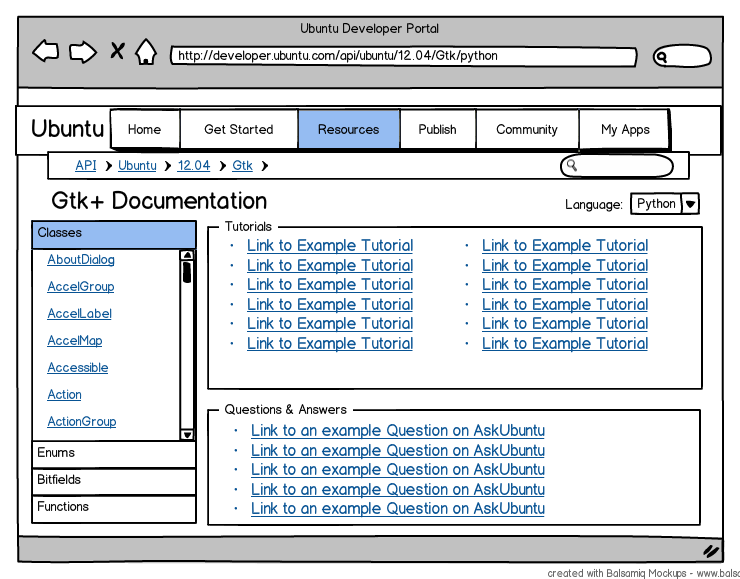
Element Page
When a user clicks on a class, enum or bitfield we see the information page. This page has a number of features:
- The page is broken into sections, links to each section are displayed at the top of the page.
- The class definition, heirarchy and an example screenshot (of relevant) are displayed first
- The API (constructors, methods, signal and properties) are shown below the class definition
- This reference content is displayed for the appropriately selected language (the language selector is at the top of all pages).
Sections for code snippets, tutorials and AskUbuntu questions are displayed below the API, with links for submitting additional content for those sections
- We would enable Disqus commenting on each page too.
- The quick reference list of classes, enums and top-level functions remains available on the left-hand side.
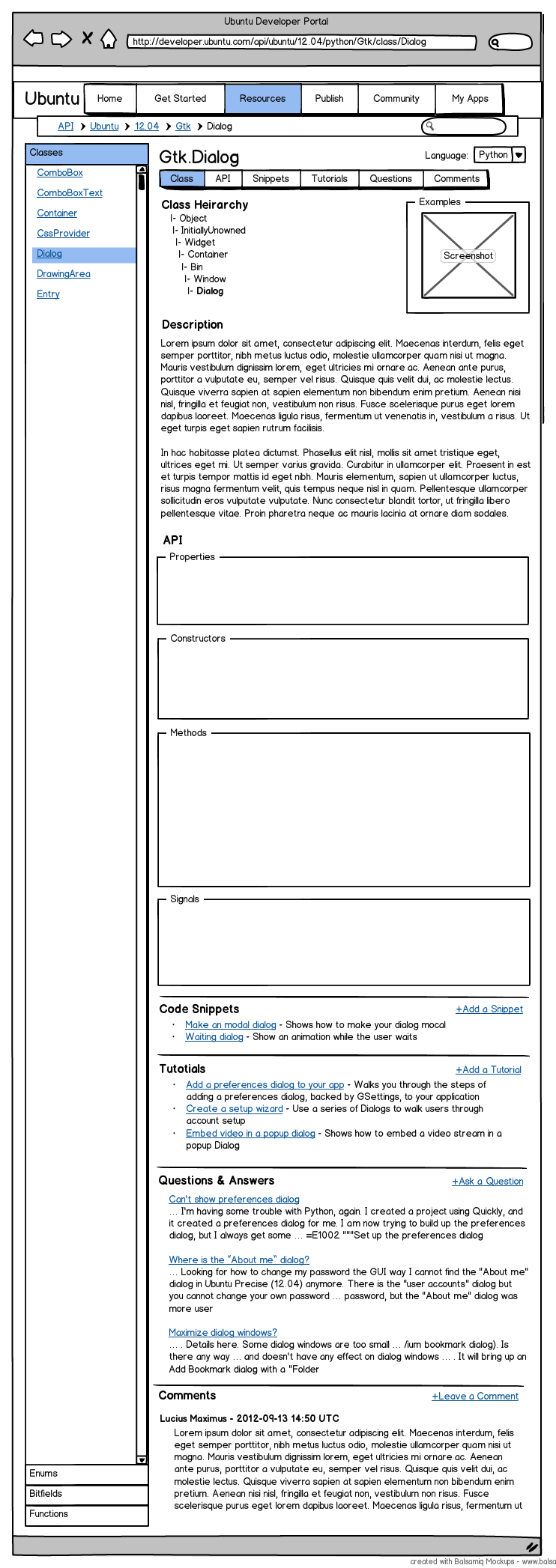
Search Results Page
TODO: Define this page |
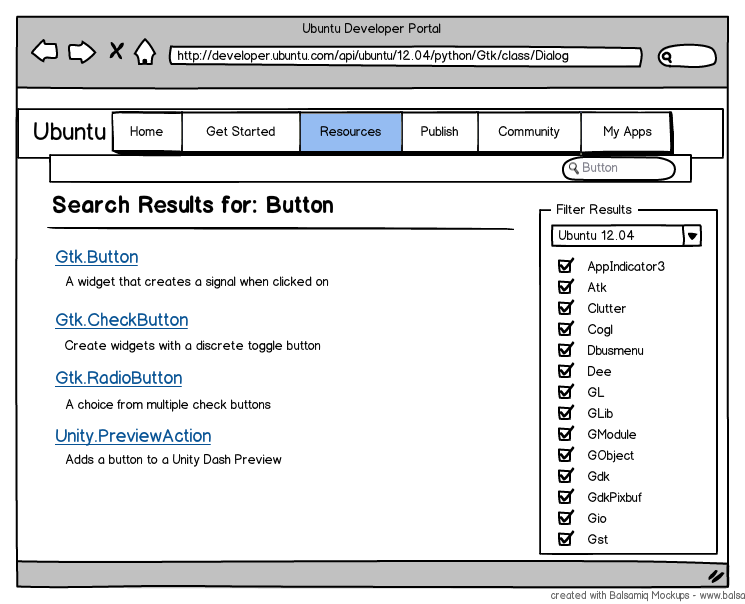
Editing Content
To edit content users will need to be in a particular launchpad group (for example the docs team could be part of the group) and users who have permission will see small edit button next to each field (similar to Launchpad). There inline editing can occur:
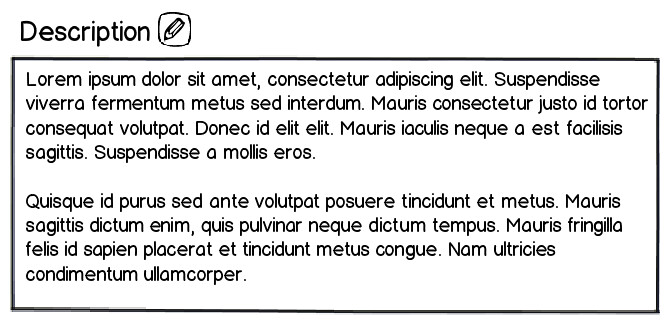
The site would support markdown format to make it easy for users to edit and submit content.
Management Commands
import-qt
Given a Qt library XML file (qdoc DITA output), import its data into the database. If a previous version of the same namespace if specified, forward copy all related records (snippets, tutorials, questions and comments.
create-release
Given a distro and previous release, create a new release record and forward-copy the previous release's platform items to it.
User stories
- Alice is writing an new app in QML, she wants to lookup specific QML components as well as their methods, properties and signals.
- Bob is adding an Application Indicator to his program, and needs to see the correct API to use as well as example of it's use.
Work Items
Item |
Section |
Status |
Notes |
Management |
|||
Import Qt API metadata |
Qt Parser |
TODO |
Need to identify what format we can get this data in |
import-qt command |
Qt Parser |
TODO |
Needs to process all Qt metadata docs in a directory |
create-release command |
Release Management |
TODO |
Needs to forward-copy platform defintions |
Backend (Django) |
|||
Language model |
Data models |
DONE |
|
Distribution model |
Data models |
DONE |
|
Release model |
Data models |
DONE |
|
PlatformSection model |
Data models |
DONE |
|
PlatformItem model |
Data models |
DONE |
|
Namespace model |
Data models |
DONE |
|
Element model |
Data models |
DONE |
|
Class model |
Data models |
DONE |
|
BitField model |
Data models |
DONE |
|
Enum model |
Data models |
DONE |
|
Link model |
Data models |
DONE |
|
Snippet model |
Data models |
DONE |
|
Image model |
Data models |
DONE |
|
Index view |
Views |
TODO |
Provide a list of active Distro records |
Distro view |
Views |
TODO |
Provide a list of active DistroRelease records for a distro |
Release view |
Views |
TODO |
Provide a list of PlatformItems, grouped by PlatformSection, plus tutorials and questions for a release |
Element view |
Views |
TODO |
Provide class, methods, signals, properties, questions, tutorials, snippets and images |
Search view |
Views |
TODO |
Provide a list of classes, methods, signals or properties that match a search term |
Text editing |
Views |
TODO |
Accept data submitted from inline text editing |
Frontend (HTML/CSS) |
|||
Base template |
Templates |
INPROGRESS |
Use ubuntu-community-webthemes (See mockups) |
Index template |
Templates |
TODO |
List all DistroReleases with links to their Release page (See mockups) |
Release template |
Templates |
TODO |
Group Namespaces by section, providing links for each supported language (See mockups) |
Class template |
Templates |
TODO |
(See mockups) |
Search template |
Templates |
TODO |
(See mockups) |
Text editing |
Scripting |
TODO |
Allow inline text editing for those with permission |
Images display |
Scripting |
TODO |
Provide a popup/lightbox for viewing multiple images |
Unresolved issues
DeveloperNetwork (last edited 2013-05-27 17:36:58 by mhall119)
